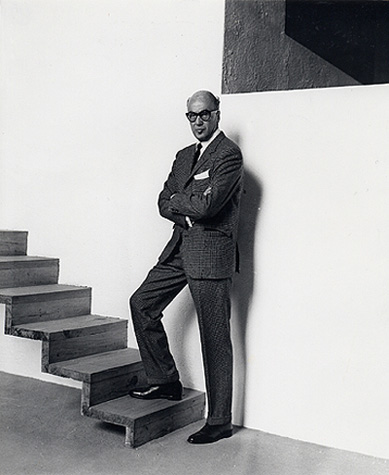Luis Barragán (Luis Ramiro Barragán Morfín)

Barragán was born in Guadalajara in Jalisco, Mexico. Educated as an engineer, he graduated from the Escuela Libre de Ingenieros in Guadalajara in 1923. After graduation, he travelled through Spain and France. While in France he became aware of the writings of Ferdinand Bac, a German-French writer, designer and artist who Barragán cited throughout his life. In 1931, he again traveled to France with a long stop-over in New York. In this trip he met Mexican mural painter José Clemente Orozco, architectural magazine editors, and Frederick Kiesler. In France he briefly met Le Corbusier and finally visited the gardens realized by Ferdinand Bac. He practiced architecture in Guadalajara from 1927–1936, and in Mexico City thereafter. His Guadalajara work includes over a dozen private homes in the Colonia Americana area of what is today near downtown Guadalajara. These homes, within walking distance of each other, include Barragán’s earliest residential projects. One of his first buildings, Casa Cristo, was restored and houses the state’s Architects’ Guild.
In 1945 he started planning the residential development of Jardines del Pedregal. In 1947 he built his own house and studio in Tacubaya and in 1955 he rebuilt the Convento de las Capuchinas Sacramentarias in Tlalpan, Mexico City, and the plan for Jardines del Bosque in Guadalajara. In 1957 he planned Torres de Satélite (whose iconic towers he created in collaboration with sculptor Mathias Goeritz) and an exclusive residential area, Las Arboledas, a few kilometers away from Ciudad Satélite. In 1964 he designed, alongside architect Juan Sordo Madaleno, the Lomas Verdes residential area, also near the Satélite area, in the municipality of Naucalpan, Estado de México. In 1967 he created one of his best-known works, the San Cristóbal Estates equestrian development in Mexico City. Barragán attended lectures by Le Corbusier and became influenced by European modernism. The buildings he produced in the years after his return to Mexico show the typical, clean lines of the Modernist movement. Nonetheless, according to Andrés Casillas (who worked with Barragán), he eventually became entirely convinced that the house should not be “a machine for living.” Opposed to functionalism, Barragán strove for an “emotional architecture” claiming that “any work of architecture which does not express serenity is a mistake.” Barragán always used raw materials such as stone or wood. He combined them with his incredibly creative use of light.
Barragán worked for years with little acknowledgement or praise until 1975 when he was honored with a retrospective at the Museum of Modern Art in New York. In 1980, he became the second winner of the Pritzker Architecture Prize. His house and studio, built in 1948 in Mexico City, were listed as a UNESCO World Heritage site in 2004. The work of Luis Barragán is often (and misleadingly) quoted in reference to minimalist architecture. John Pawson, in his book Minimum, includes images from some of Barragán’s projects. Most architects who do minimalistic architecture do not use color, but the ideas of forms and spaces which Barragán pioneered are still there. There have been several essays written by the Pritzker Prize recipient Alvaro Siza in prefaces to books that make reference to the ideas of Barragán as well. It has also been proved that Louis Kahn informally consulted Barragán on the space between the buildings of the Salk Institute in La Jolla, California. According to the documents, Kahn’s original idea was to place a garden between the buildings; however, Barragán suggested that an open plaza, with only a water feature in between, would better reflect the spirit of the location. This area, possibly designed with Barragán’s advice in mind, is arguably the most impressive aspect of the building complex. Barragán’s influence can also be seen in the work of many of Mexico’s contemporary architects, such as Ricardo Legorreta.
Born
- March, 09, 1902
- Mexico
- Guadalajara, Jalisco
Died
- November, 22, 1988
- Mexico City, Mexico

